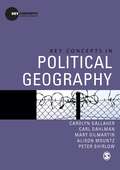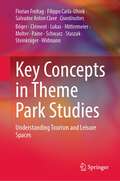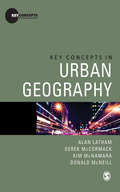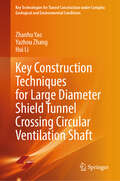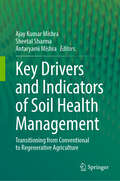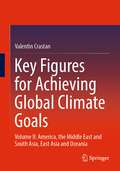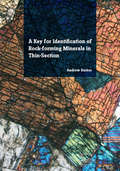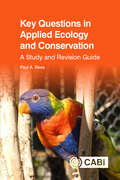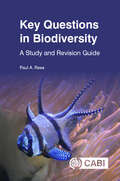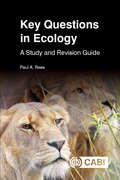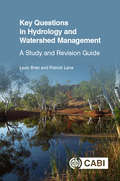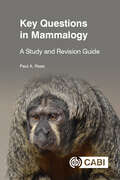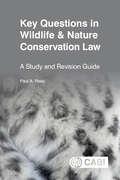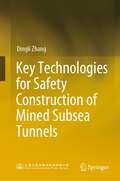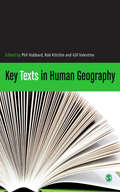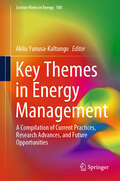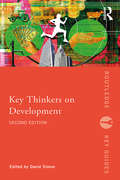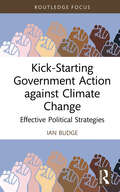- Table View
- List View
Key Concepts in Political Geography (Key Concepts in Human Geography)
by Carolyn Gallaher Carl T. Dahlman Mary Gilmartin Alison Mountz Peter ShirlowThis is a new kind of textbook that forms part of an innovative set of companion texts for the human geography subdisciplines. Organized around 20 short essays, Key Concepts in Political Geography provides a cutting-edge introduction to the central concepts that define contemporary research in the field. Involving detailed yet expansive discussions, the book includes: • an introductory chapter providing a succinct overview of the recent developments in the field • over 20 key concept entries covering the expected staples of the sub-discipline, such as nationalism, territoriality, scale and political-economy, as well as relatively new arrivals to the field including the other, anti-statism, gender, and post-conflict • extensive pedagogic features that enhance understanding including a glossary, figures, diagrams and further reading.
Key Concepts in Theme Park Studies: Understanding Tourism and Leisure Spaces
by Florian Freitag Filippo Carlà-Uhink Salvador Anton ClavéThis book offers a comprehensive, multidisciplinary introduction to theme parks and the field of theme park studies. It identifies and discusses relevant economic, social, and cultural as well as medial, historical, and geographical aspects of theme parks worldwide, from the big international theme park chains to smaller, regional, family-operated parks. The book also describes the theories and methods that have been used to study theme parks in various academic disciplines and reviews the major contexts in which theme parks have been studied. By providing the necessary backgrounds, theories, and methods to analyze and understand theme parks both as a business field and as a socio-cultural phenomenon, this book will be a great resource to students, academics from all disciplines interested in theme parks, and professionals and policy-makers in the leisure and entertainment as well as the urban planning sector.
Key Concepts in Urban Geography (Key Concepts in Human Geography)
by Derek Mccormack Kim Mcnamara Donald Mcneill Dr Alan LathamKey Concepts in Urban Geography is a new kind of textbook that forms part of an innovative set of companion texts for the human geography subdisciplines. Organized around 20 short essays, Key Concepts in Urban Geography provides a cutting-edge introduction to the central concepts that define contemporary research in urban geography. Involving detailed and expansive discussions, the book includes: * an introductory chapter providing a succinct overview of the recent developments in the field * over 20 key concept entries with comprehensive explanations, definitions and evolutions of the subject * extensive pedagogic features that enhance understanding including a glossary, figures, diagrams and further reading. This is an ideal companion text for upper-level undergraduate and postgraduate students in urban geography and covers the expected staples of the subdiscipline from global cities and urban nature to transnational urbanism and virtuality.
Key Construction Techniques for Large Diameter Shield Tunnel Crossing Circular Ventilation Shaft (Key Technologies for Tunnel Construction under Complex Geological and Environmental Conditions)
by Hui Li Zhanhu Yao Yazhou ZhangBased on the construction of Nanjing Weisan Road Yangtze River Tunnel, this book comprehensively introduces the new technology of large-diameter shield tunnel construction crossing circular air shafts. It focuses on four aspects: the construction technology of super-deep circular air shaft foundation pit retaining structure in the sensitive environment near the river, underwater excavation and underwater massive concrete sealing bottom construction technology, adaptive improvement of TBM and construction technology of crossing air shaft, and control technology of super-deep foundation pit stability during the process of conversion. This book combines theory with practice, and can provide reference for shield engineering construction. It can also be used as a reference for engineering and technical personnel, researchers, teachers and students in related majors in colleges who are engaged in shield tunnel engineering.
Key Drivers and Indicators of Soil Health Management: Transitioning from Conventional to Regenerative Agriculture
by Ajay Kumar Mishra Sheetal Sharma Antaryami MishraThis book explores the crucial transition from conventional to regenerative agriculture practices, focusing on the key drivers and indicators of soil health management. It provides knowledge to implement sustainable agricultural systems that prioritize soil health and foster the transition toward regenerative practices. This book delves into the principles and concepts of soil health, the challenges and limitations of conventional agriculture, the assessment of soil health through various indicators, and the importance of cover crops, crop rotation, conservation tillage, nutrient management, and water conservation practices. It also addresses the role of soil biodiversity, policy frameworks, and scaling up regenerative agriculture, providing practical strategies and case studies. The target audience for this book ranges from students and researchers to policymakers and large-scale farmers. Farmers will benefit from the practical insights and strategies presented, and policymakers and agricultural organizations can gain valuable knowledge on the drivers and policy frameworks supporting sustainable agriculture and soil health management. This book explores the crucial transition from conventional to regenerative agriculture practices, focusing on the key drivers and indicators of soil health management. It provides knowledge to implement sustainable agricultural systems that prioritize soil health and foster the transition toward regenerative practices. This book delves into the principles and concepts of soil health, the challenges and limitations of conventional agriculture, the assessment of soil health through various indicators, and the importance of cover crops, crop rotation, conservation tillage, nutrient management, and water conservation practices. It also addresses the role of soil biodiversity, policy frameworks, and scaling up regenerative agriculture, providing practical strategies and case studies. The target audience for this book ranges from students and researchers to policymakers and large-scale farmers. Farmers will benefit from the practical insights and strategies presented, and policymakers and agricultural organizations can gain valuable knowledge on the drivers and policy frameworks supporting sustainable agriculture and soil health management.
Key Figures for Achieving Global Climate Goals: Volume II: America, the Middle East and South Asia, East Asia and Oceania
by Valentin CrastanThis volume analyses the energy industry for the following geographical units: America – divided into North America (Canada + USA) and Central and South America –, the Middle East and South Asia, East Asia and Oceania. The key energy-economic indicators for each region and country and their development, are illustrated in numerous graphs and energy flow diagrams. Based on this analysis, the author recommends a distribution of emission reductions necessary to limit climate change (for the 2°C and 1.5°C climate goals, with a perspective up to 2050).The continents covered in this volume collectively account for 77% of emissions. Europe + Eurasia and Africa will be addressed in volume I.
A Key for Identification of Rock-Forming Minerals in Thin Section
by Andrew J. BarkerStructured in the form of a dichotomous key, comparable to those widely used in botany, the mineral key provides an efficient and systematic approach to identifying rock-forming minerals in thin-section. This unique approach covers 150 plus of the most commonly encountered rock-forming minerals, plus a few rarer but noteworthy ones. Illustrated in full colour, with 330 plus high quality mineral photomicrographs from a worldwide collection of igneous, metamorphic, and sedimentary rocks, it also provides a comprehensive atlas of rock-forming minerals in thin-section.Commencing with a brief introduction to mineral systems, and the properties of minerals in plane-polarised and cross-polarised light, the mineral key also includes line drawings, tables of mineral properties and an interference colour chart, to further aid mineral identification. To minimise the chance of misidentification, and enable less experienced petrologists to use the key with confidence, the key has been arranged to prioritise those properties that are most easily recognised.Designed for simplicity and ease of use, it is primarily aimed at undergraduate and postgraduate students of mineralogy and petrology, but should also provide a valuable source of reference for all practising geologists dealing with rock thin sections and their interpretation.
Key Questions in Applied Ecology and Conservation: A Study and Revision Guide (Key Questions)
by Dr Paul ReesAn understanding of applied ecology and conservation is an important requirement of a wide range of programmes of study including applied biology, ecology, environmental science and wildlife conservation. This book is a study and revision guide for students following such programmes. It contains 600 multiple-choice questions (and answers) set at three levels - foundation, intermediate and advanced - and grouped into 10 major topic areas: History and foundations of applied ecology and conservation Environmental pollution and perturbations Wildlife and conservation biology Restoration biology and habitat management Agriculture, forestry and fisheries management Pest, weed and disease management Urban ecology and waste management Global environmental change Environmental and wildlife law and policy Environmental assessment, monitoring and modelling The book has been produced in a convenient format so that it can be used at any time in any place. It allows the reader to learn and revise the meaning of terms used in applied ecology and conservation, study the effects of pollution on ecosystems, the management, conservation and restoration of wildlife populations and habitats, urban ecology, global environmental change, environment law and much more. The structure of the book allows the study of one topic area at a time, progressing through simple questions to those that are more demanding. Many of the questions require students to use their knowledge to interpret information provided in the form of graphs, data or photographs.
Key Questions in Biodiversity: A Study and Revision Guide (Key Questions)
by Dr Paul ReesAn understanding of biodiversity is an important requirement of a wide range of programmes of study including biology, zoology, wildlife conservation and environmental science. This book is a study and revision guide for students following such programmes in which biodiversity is an important component. It contains 600 multiple-choice questions (and answers) set at three levels - foundation, intermediate and advanced - and grouped into 10 major topic areas: 1. Principles of classification and taxonomy 2. Comparative anatomy and physiology 3. Protoctists, monerans, fungi, lichens and acellular organisms 4. 'Lower' plants and pteridophytes 5. Seed-bearing plants 6. Sponges, cnidarians, nematodes and minor animal phyla 7. Platyhelminths, annelids and molluscs 8. Arthropods and echinoderms 9. Fishes, amphibians and reptiles 10. Birds and mammals The book has been produced in a convenient format so that it can be used at any time in any place. It allows the reader to learn and revise the meaning of terms used in animal and plant classification, the principles of comparative physiology, and the characteristics of, and diversity in, the major animal and plant taxa. The structure of the book allows the study of one topic area or group of taxa at a time, progressing through simple questions to those that are more demanding. Many of the questions require students to use their knowledge to identify organisms and biological structures from drawings or photographs.
Key Questions in Ecology: A Study and Revision Guide (Key Questions)
by Dr Paul ReesAn understanding of ecology is an important requirement of a wide range of academic areas, including biology, zoology and environmental science. This book is a study and revision guide for students following programmes of study in which ecology is an important component. It contains 600 multiple-choice questions (and answers) set at three levels - foundation, intermediate and advanced - and grouped into 10 major topic areas: · The history and foundations of ecology · Abiotic factors and environmental monitoring · Taxonomy and biodiversity · Energy flow and production ecology · Nutrient and material cycles · Ecophysiology · Population ecology · Community ecology and species interactions · Ecological genetics and evolution · Ecological methods and statistics The book has been produced in a convenient format so that it can be used at any time in any place. It allows the reader to learn and revise the meaning of ecological terms, the basic processes operating in ecosystems, the dynamics of populations, ecological genetics and the process of evolution, the methods used in ecological surveys, and much more. The structure of the book allows the study of one topic area at a time, progressing through simple questions to those that are more demanding. Many of the questions require students to use their knowledge to interpret information provided in the form of graphs, data or photographs, providing a useful tool for independent study.
Key Questions in Hydrology and Watershed Management: A Study and Revision Guide (Key Questions)
by Professor Leon Bren Professor Patrick LaneThis book provides a series of exercises of various types covering matters of hydrology and watershed management. The exercises include true/false questions, multiple choice questions, and numeric, graphical, and analytical exercises. The questions draw on the basic disciplines of hydrology and physics, with some stress placed on correct or appropriate units. The questions reflect the authors' many years of teaching watershed management at undergraduate and graduate levels. Questions cover: 1. Terminology and measurement of flow (and units) 2. Quantifying stream networks 3. Concepts of water balance and evapotranspiration 4. Slope recharge, groundwater hydrology, and water-table/phreatic aquifers 5. Single and paired watershed experiments 6. Impacts of fires on watersheds 7. Concepts and measurements of water quality 8. Flooding forests 9. Valuation of water 10. Protection of forest stream by buffers 11. Urban watershed concepts The book is self-contained, and designed to be used at any time in any place, either for revision or as source material for teaching. The work is graded so that easier questions are presented early, followed by harder questions. Answers are concise but contain enough information to help students study and revise on a topic-by-topic basis. The book concludes with suggestions for student exercises and projects and is an invaluable resource for both students and instructors.
Key Questions in Mammalogy: A Study and Revision Guide (Key Questions)
by Dr Paul ReesAlthough mammals comprise a relatively small proportion of total biodiversity they are disproportionately represented in courses in biology and zoology and they are the dominant taxon in zoos around the world. Mammalogy is well-established as a discrete element of biological courses in some parts of the world, notably in North America. This book is intended as a study and revision guide for students following programmes of study in which mammalogy is an important component. It comprises 600 multiple-choice questions (and answers) set at three levels - foundation, intermediate and advanced - grouped into 10 major topic areas: 1. The history and principles of mammalogy 2. Origins, evolution and taxonomy 3. Anatomy 4. Physiology 5. Behaviour 6 Ecology and genetics 7. Zoogeography 8. Conservation and management 9. Parasites and diseases 10. Domestication and human use of animals The book is designed to be used at any time in any place. It allows the reader to study the meaning of terms used in mammalogy, the history of mammalogy, the taxonomy, evolution and genetics of mammals, their zoogeography, their anatomy, physiology and adaptations to their environment, their behaviour, their conservation and management, their diseases, and their domestication and use by humans. Some of the questions will require students to use their knowledge to interpret information provided in the form of graphs, data, maps or photographs
Key Questions in Wildlife & Nature Conservation Law: A study and revision guide (Key Questions)
by Dr Paul ReesLaw plays an essential part in the conservation of wildlife and ecosystems. The study of wildlife and nature conservation law is an important component of a wide range of programmes of study including wildlife conservation, environmental management and environmental law. This book is a study and revision guide for students following such programmes. It contains 600 multiple choice questions (and answers) set at three levels - foundation, intermediate and advanced - and grouped into 10 major topic areas: 1. Principles of Wildlife and Nature Conservation Law 2. History of Wildlife and Nature Conservation Law 3. Species Protection and Exploitation I - EU and International Law 4. Species Protection and Exploitation II - National Laws 5. Protected Areas and Habitats I - EU and International Laws 6. Protected Areas and Habitats II - National Laws 7. Planning, Pollution, Restoration and Conservation Funding 8. Wildlife Trade, Animal Collections and Alien Species 9. Wildlife Law Enforcement and Penalties 10. Legal Texts This book has been produced in a convenient format so that it can be used at any time, in any place. It allows the reader to learn and revise the meaning of terms used in wildlife and nature conservation law and study the role of legislation at national, European Union (EU) and international level in the protection of individual species, habitats and landscapes. It uses examples from a wide variety of taxa, habitats and protected areas selected from a range of jurisdictions from the United Kingdom, the United States and Australia to Antarctica and the High Seas. Topics include the control of hunting, the conservation of trees and forests, the protection of National Parks and wilderness areas, wildlife trade and the organisations involved in the enforcement of wildlife laws. The structure of the book allows the study of one topic area at a time, progressing through simple questions to those that are more demanding. Some of the questions require students to use their knowledge to interpret information provided in the form of photographs and legal texts.
Key Technologies for Safety Construction of Mined Subsea Tunnels
by Dingli ZhangThis book puts forward a technological system for the construction of subsea tunnel using drilling and blasting method. Taking the water-induced disaster as the core risk, the safety guarantee system for large cross-sectional subsea tunnels is established. The composite grouting technology referred to ground reinforcement and water plugging is established, which breaks through the technical bottleneck of subsea tunnel construction in highly permeable strata. The process control theory based on water inrush mechanism is created, which gets rid of the over-dependence on engineering experience for disaster control of submarine tunnel. An active control waterproof drainage system based on the synergy of reinforcement ring and support system is invented to solve the contradiction between the control of water displacement and water pressure. The above-mentioned achievements have been successfully applied in the first three large cross-sectional subsea tunnels in China, and have played a key role in the construction safety. The proposed technological system can improve the overall construction level of subsea tunnel, which can provide reference for the design and construction of subsea tunnels, especially for those crossing through weakness zones.
Key Texts in Human Geography
by Gill Valentine Rob Kitchin Dr Phil Hubbard"A book that will delight students... Key Texts in Human Geography is a primer of 26 interpretive essays designed to open up the subject's landmark monographs of the past 50 years to critical interpretation... The essays are uniformly excellent and the enthusiasm of the authors for the project shines through... It will find itself at the top of a thousand module handouts." - THE Textbook Guide "Will surely become a 'key text' itself. Read any chapter and you will want to compare it with another. Before you realize, an afternoon is gone and then you are tracking down the originals." - Professor James Sidaway, University of Plymouth 'An essential synopsis of essential readings that every human geographer must read. It is highly recommended for those just embarking on their careers as well as those who need a reminder of how and why geography moved from the margins of social thought to its very core." - Barney Warf, Florida State University Undergraduate geography students are often directed to 'key' texts in the literature but find them difficult to read because of their language and argument. As a result, they fail to get to grips with the subject matter and gravitate towards course textbooks instead. Key Texts in Human Geography serves as a primer and companion to the key texts in human geography published over the past 40 years. It is not a reader, but a volume of 26 interpretive essays highlighting: the significance of the text how the book should be read reactions and controversies surrounding the book the book's long-term legacy. It is an essential reference guide for all students of human geography and provides an invaluable interpretive tool in answering questions about human geography and what constitutes geographical knowledge.
Key Themes in Energy Management: A Compilation of Current Practices, Research Advances, and Future Opportunities (Lecture Notes in Energy #100)
by Akilu Yunusa-KaltungoThis book provides a comprehensive global coverage of energy management as it relates mostly to developing countries. In an era of unprecedented global population growth, the demand for energy has reached staggering levels. The United Nations reported an enormous 200% increase in population between 1950 and 2020, with projections indicating a further rise to 10.9 billion by 2100. As a direct consequence, global primary energy usage has surged from 3701 Mtoe in 1965 to 13511 Mtoe in 2017, putting immense strain on existing energy sources. If current growth rates persist, these sources could be depleted within a mere 130 years. To address this impending crisis, governments worldwide have implemented regulations and incentives to promote energy conservation. While numerous studies and publications have emerged within the field of energy management, there remains a significant research gap, particularly concerning the energy challenges faced by developing countries. Existing edited books on energy-related topics often narrowly focus on specific aspects, hindering readers from gaining a holistic understanding of energy management challenges and potential solutions. This book fills this void. Recognizing the pivotal role these nations play in achieving sustainable development goals, this book provides a wide-ranging perspective on the trends, challenges, and potential solutions to energy crises in these regions. It not only acknowledges the challenges faced by developing countries but also offers viable strategies to address them. The editor, leveraging his successful leadership experience in global academic endeavors, including publishing a book on Occupational Safety & Health practices during the COVID-19 era and coordination of multinational research projects, is well positioned to bring together exceptional chapters from various countries. His extensive network ensures the inclusion of diverse perspectives, enriching the book's content and offering invaluable insights to readers. Designed for a broad readership, including energy industry organizations, professionals, researchers, government bodies, policymakers, and students, this book delves into a wide array of energy management issues. By facilitating a comprehensive understanding of the subject, it equips readers with the knowledge and tools necessary to navigate the complex landscape of energy management in the modern world.
Key Thinkers on Development (Routledge Key Guides)
by David SimonSince its publication in 2006 as Fifty Key Thinkers on Development, this invaluable reference has established itself as the leading biographical handbook in its field, providing a concise and accessible introduction to the lives and key contributions of development thinkers from across the ideological and disciplinary spectrum. This substantially expanded and fully updated second edition in the relaunched series without the numerical constraint includes an additional 24 essays, filling in many gaps in the original selection, greatly improving the gender balance and diversifying coverage to reflect the evolving landscape of development in theory, policy and practice. It presents a unique guide to the lives, ideas and practices of leading contributors to the contested terrain of development studies and development policy and practice. Its thoughtful essays reflect the diversity of development in theory, policy and practice across time, space, disciplines and communities of practice. Accordingly, it challenges Western-centrism, Orientalism and the like, while also demonstrating the enduring appeal of "development" in different guises. David Simon has assembled a highly authoritative team of contributors from different backgrounds, regional settings and disciplines to reflect on the lives and contributions of leading authorities on development from around the world. These include: Modernisers like Kindleberger, Perroux and Rostow Dependencistas such as Frank, Furtado, Cardoso and Amin Progressives and critical modernists like Hirschman, Prebisch, Helleiner Sen, Streeten and Wang Political leaders enunciating radical alternative visions of development, such as Mao, Nkrumah and Nyerere Progenitors of religiously or spiritually inspired development, such as Gandhi, Ariyaratne and Vivekananda Development–environment thinkers like Agarwal, Blaikie, Brookfield, Ostrom and Sachs International institution builders like Singer, Hammarsköld, Kaul and Ul Haq Anti- and post-development thinkers and activists like Escobar, Ghosh, Quijano and Roy Key Thinkers on Development is therefore the essential handbook on the world’s most influential development thinkers and an invaluable guide for students of development and sustainability, policy-makers and practitioners seeking an accessible overview of this diverse field and its leading voices.
Key Thinkers on the Environment (Routledge Key Guides)
by Joy A. Palmer Cooper David E. CooperKey Thinkers on the Environment is a unique guide to environmental thinking through the ages. Joy A. Palmer Cooper and David E. Cooper, themselves distinguished authors on environmental matters, have assembled a team of expert contributors to summarize and analyse the thinking of diverse and stimulating figures from around the world and from ancient times to the present day. Among those included are: philosophers such as Rousseau, Kant, Spinoza and Heidegger activists such as Chico Mendes and Wangari Maathai literary giants such as Virgil, Goethe and Wordsworth major religious and spiritual figures such as Buddha and St Francis of Assissi eminent scientists such as Darwin, Lovelock and E.O. Wilson. Lucid, scholarly and informative, the essays contained within this volume offer a fascinating overview of humankind’s view and understanding of the natural world.
Key to The Future: The History of Earth Science
by John CaterHere is a book for everyone who has an interest in how our planet works, what has happened during its 4,550 million year history and what might happen in the future. It tells how Earth scientists study the pattern of events that have shaped the planet and guided the evolution of life on Earth. In clear and simple language it describes how the effec
Khazan Ecosystems of Goa
by Sangeeta M. SonakThis book elaborates on the Khazan ecosystems of Goa, India. Khazans are human-managed ecosystems, which are reclaimed from coastal wetlands, salt marshes and mangrove areas, where tidal influence is regulated through a highly structured system of dykes, canals, furrows, and sluice gates using resources that are amply available locally. Khazan ecosystems are marvels of tribal engineering. They are a simple architectural design, which operate at a very low running cost using tidal, hydro, and solar energy. The design contributes to a highly complex but eco-friendly ecosystem integrating agriculture, aquaculture and salt panning. . Khazan ecosystems have been functional for the last 3500 years. The history of Khazans is very ancient and can be traced to the transition from food gathering to food growing, which has been regarded as the biggest step in the history of human civilization. Khazan ecosystems thus have a high historical and world heritage value. They are also repositories of global biodiversity, with unique flora suitable to their unique and highly variable environment. They are endemic and heritage ecosystems of Goa and ultimately reservoirs of history and heritage. Using the example of the Khazan lands, the book analyzes and comments on traditional ecological knowledge and indigenous technology. It presents the evolution of Khazan management institutions over a period of more than three thousand years, as well as factors that have contributed to its decline in recent years It develops a conceptual framework for ecosystem performance and suggests strategies for conservation of Khazans as well as strategies to build on these indigenous adaptation mechanisms to cope with the global environmental change.
Kick-Starting Government Action against Climate Change: Effective Political Strategies (Routledge Advances in Climate Change Research)
by Ian BudgeWith drastic action needing to be taken now, rather than over the 30 years to 2050, this book addresses the crucial question of how to get action from governments who will always put short-term considerations (e.g. post Covid economic growth) over longer term climate priorities – unless forced to do otherwise. How might governments be persuaded to implement policies that will result in effective action? And how can this be achieved at an international, as well as national, level? These are the questions that this book focuses on. Taking a systematic political science point of view and drawing on collective choice and other theories of political action, this book analyses the key political and economic dynamics shaping climate policies around the world, identifying major political opportunities that can be exploited by well-informed and determined political actors, such as NGOs and social movements. This book describes how to advance and accelerate climate action around the world and will be of interest internationally to climate change campaigners, activists, political and environmental scientists.
A Kids Book About Climate Change: Kids Are Ready (A Kids Book)
by Zanagee Artis Olivia GreenspanExplore the impact of climate change and empower kids to be proactive to protect our world.This is a kid's book about climate change. Climate change is a topic that can be overwhelming for kids and grownups. So if you're looking for the best place to better understand the climate crisis, look no further!This book helps kids aged 5-9 understand what climate change means, giving them the power to make a difference. Learn the facts about climate change, explain what the state of our planet is, how it got there, and give them hope to fight for their future.A Kids Book About Climate Change features: - A large and bold, yet minimalist font design that allows kids freedom to imagine themselves in the words on the pages.- A friendly, approachable and empowering, kid-appropriate tone throughout.- An incredible and diverse group of authors in the series who are experts or have first-hand experience of the topic.Tackling important discourse together! The A Kids Book About series are best used when read together. Helping to kickstart challenging, empowering, and important conversations for kids and their grownups through beautiful and thought-provoking pages. The series supports an incredible and diverse group of authors, who are either experts in their field, or have first-hand experience on the topic. A Kids Co. is a new kind of media company enabling kids to explore big topics in a new and engaging way. With a growing series of books, podcasts and blogs, made to empower. Learn more about us online by searching for A Kids Co.
Kids Book About Safety, A (A Kids Book)
by Soraya SutherlandThis book empowers kids through a simple, step-by-step plan to keep them and their families safe during potential emergency situations.What would you do if an earthquake happened? How about a house fire? Or maybe a tornado? Emergency situations can be scary to think about, but we can feel confident and empowered in dangerous situations if we do one simple thing: be prepared! This book shows kids that by knowing what disasters could happen, and what to do if they occur, makes you ready and can even save lives.
Kids Book About Sustainability, A (A Kids Book)
by Amber TroutmanWe can all choose sustainable practices today to improve the health of our planet for ourselves and future generations!Sustainability is a long word that simply means to live on this Earth in a responsible way. We do this for ourselves, for all fellow inhabitants, current and future, and for the planet itself. Open this book and learn the good and not-so-good impact our actions have on the Earth. And, importantly, how we can start living sustainably today. Lasting change takes time, and our choices really matter!
The Kid's Book of the Elements: An Awesome Introduction to Every Known Atom in the Universe
by Theodore GrayA fun, fascinating, and amazingly photographic exploration of the periodic table, for curious kids who want to understand how atoms and elements make up everything in the universe.In this very special kids' edition of Theodore Gray's The Elements, budding scientists, ages 6 to 9, will learn all about every element in the periodic table from the first element, Hydrogen (1), to the very last element, Oganesson (118). Filled with great big colorful photographs and fun facts for every element, The Kid's Book of The Elements is the perfect introduction to the fascinating world of chemistry and visual/tactile-based STEM/STEAM learning. This edition also includes 120 sturdy tear-out cards of each element for kids to play with and arrange on their own.
